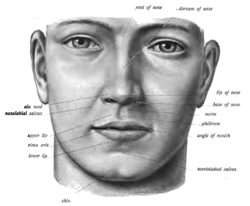Philtrum
| Philtrum | |
|---|---|

Philtrum visible at centre
|
|

Dog philtrum
|
|
| Details | |
| Precursor | medial nasal prominence |
| Identifiers | |
| Dorlands /Elsevier |
12635445 |
| TA | A05.1.01.007 |
| FMA | 59819 |
|
Anatomical terminology
[]
|
|
The philtrum (Latin: philtrum, Greek: φίλτρον philtron, lit. "love charm"), or medial cleft, is a vertical groove in the middle area of the upper lip, common to many mammals, extending in humans from the nasal septum to the procheilon. Together with a glandular rhinarium and slit-like nostrils, it is believed to constitute the primitive condition for mammals in general.
In most mammals, the philtrum is a narrow groove that may carry dissolved odorants from the rhinarium or nose pad to the vomeronasal organ via ducts inside the mouth.
For humans and most primates, the philtrum survives only as a vestigial medial depression between the nose and upper lip.
The human philtrum, bordered by ridges, also is known as the infranasal depression, but has no apparent function. That may be because most higher primates rely more on vision than on smell.Strepsirrhine primates, such as lemurs, still retain the philtrum and the rhinarium, unlike monkeys and apes.
In humans, the philtrum is formed where the nasomedial and maxillary processes meet during embryonic development (colloquially known as Hulse lines). When these processes fail to fuse fully in humans, a cleft lip (sometimes called a "hare lip") may result.
A flattened or smooth philtrum may be a symptom of fetal alcohol syndrome or Prader–Willi syndrome.
A study of boys diagnosed with autism spectrum disorders found that a broader than average philtrum is one of a cluster of physical abnormalities associated with autism.
...
Wikipedia
